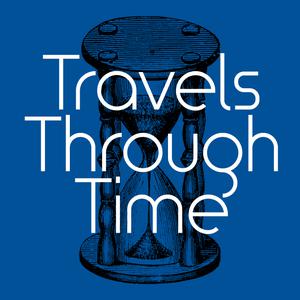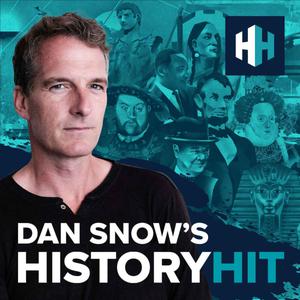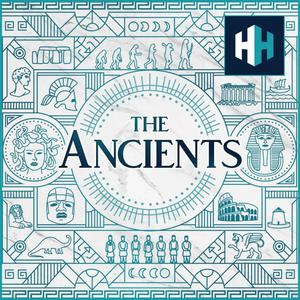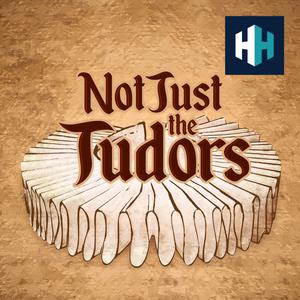
Travels Through Time
Travels Through Time
In each episode we ask one of the world's leading historians the tantalising question: "If you could travel back through time, what year would you visit?" They make their choice and then they tell us why. Presented by bestselling historian Peter Moore.
- 1 hour 12 minutesS.C. Gwynne: R101 – The World’s Largest Flying Machine (1930)
After a short break at TTT, enter the world’s largest flying machine.
‘R101’ was one of the most ambitious creations of the airship era. Plans for it began about a century ago in the 1920s. The vision of engineers and politicians was that the 1930s were to mark the start of a new epoch in air travel. R101 was to lead the way. Huge airships were going to glide through the imperial skies, binding together the distant outposts of the British Empire.
In 1930 R101’s story reached its tragic climax when, seven hours into a flight from its base in Bedfordshire, it crashed to the north of Paris. Of the fifty or so on board, only a handful survived the hydrogen fireball.
R101’s story, and the history of the era that created it, are the subject of a new book by the New York Time bestselling author S.C. ‘Sam’ Gwynne. His Majesty’s Airship tells the story of ‘the life and death of the world’s largest flying machine’.
In this episode Sam takes Peter back to see R101 as the moment of disaster nears.
To be in with winning one of two hardback copies of His Majesty’s Airship, just head to the Unseen Histories Instagram page and follow/like this post.
For more, as ever, visit our website: tttpodcast.com. To read an extract and see images from His Majesty’s Airship, visit unseenhistories.com
Show notes
Scene One: 30 June 1930. Royal Airship Works, Cardington. R101 is beset with problems.
Scene Two: 4 October 1930. The departure of R101 from Cardington, Bedfordshire.
Scene Three: 5 October 1930. Near Beauvais, France. The crash, and aftermath.
Memento: R101’s Control Car
People/Social
Presenter: Peter Moore
Guest: S.C. Gwynne
Production: Maria Nolan
Podcast partner: Ace Cultural Tours
Theme music: ‘Love Token’ from the album ‘This Is Us’ By Slava and Leonard Grigoryan
Follow us on Twitter: @tttpodcast_
See where 1930 fits on our Timeline
31 October 2023, 10:15 am - 53 minutes 23 secondsPeter Moore: Life, Liberty and the Pursuit of Happiness
Join Peter Moore and Sarah Bakewell for a little walking tour of Fleet Street in London. Instead of three scenes, in this episode they stop off at three locations, as Peter tells Sarah about three of the characters who appear in his new book: the printer William Strahan, the writer Samuel Johnson and the politician John Wilkes.
Peter Moore is a Sunday Times bestselling historian. His new book is Life, Liberty and the Pursuit of Happiness: Britain and the American Dream. Sarah Bakewell is a prize-winning and New York Times bestselling author, most recently of the history of humanism: Humanly Possible.
For more, as ever, visit our website: tttpodcast.com.
Show notesLocation One: The Old Cheshire Cheese (William Strahan)
Location Two: 17 Gough Square (Dr Johnson's House)
Location Three: Near John Wilkes's Statue on Fetter Lane
People/SocialPresenter: Peter Moore
Asking questions: Sarah Bakewell
Production: Maria Nolan
Podcast partner: Ace Cultural Tours
Theme music: ‘Love Token’ from the album ‘This Is Us’ By Slava and Leonard Grigoryan
Follow us on Twitter: @tttpodcast_
19 July 2023, 4:10 pm - 48 minutes 44 seconds[From the archive] Philip Hoare: Albert and the Whale (1520)
In 1520 the artist Albrecht Dürer was on the run from the Plague and on the look-out for distraction when he heard that a huge whale had been beached on the coast of Zeeland. So he set off to see the astonishing creature for himself.
In this beautifully-evoked episode the award-winning writing Philip Hoare takes us back to those consequential days in 1520. We catch sight of Dürer, the great master of the Northern Renaissance, as he searches for the whale. This, he realises, is his chance to make his greatest ever print.
Philip Hoare is the author of nine works of non-fiction, including biographies of Stephen Tennant and Noël Coward, and the studies, Wilde's Last Stand and England's Lost Eden. Spike Island was chosen by W.G. Sebald as his book of the year for 2001. In 2009, Leviathan or, The Whale won the 2009 BBC Samuel Johnson Prize for non-fiction. It was followed in 2013 by The Sea Inside, and in 2017 by RISINGTIDEFALLINGSTAR.
His new book, Albert & the Whale led the New York Times to call the author a 'forceful weather system' of his own. He is Professor of Creative Writing at the University of Southampton, and co-curator, with Angela Cockayne, of the digital projects http://www.mobydickbigread.com/ and https://www.ancientmarinerbigread.com/
As ever, much, much more about this episode is to be found at our website tttpodcast.com.
Show notesScene One: Nuremberg, home of Albrecht Dürer, at the height of its power as an imperial city, of art and technology.
Scene Two: The Low Countries. Driven out of Nuremberg by the plague and a city in lockdown, Dürer escapes to the seaside.
Scene Three: Halfway through his year away, Dürer hears a whale has been stranded in Zeeland. This is his chance to make his greatest print, a follow up to his hit woodcut of a rhinoceros. What follows next is near disaster, a mortal act. It changes his life.
Memento: Memento: A lock of Dürer’s hair (which Hoare would use to regenerate him and then get him to paint his portrait)
People/SocialPresenter: Violet Moller
Guest: Philip Hoare
Production: Maria Nolan
Podcast partner: Colorgraph
Follow us on Twitter: @tttpodcast_
Or on Facebook
See where 1520 fits on our Timeline
13 July 2023, 1:36 pm - 1 hour 1 minute[From the archive] Bernard Cornwell: The Battle of Waterloo (1815)
It's time to revisit our archives. In this episode one of the world’s great historical novelists takes us back to one of the most dramatic and consequential moments in European history. Bernard Cornwell is our guide to the Battle of Waterloo.
Waterloo. That single word is enough to conjure up images of Napoleon with his great bicorn hat and the daring emperor’s nemesis, the Duke of Wellington. Over the course of twelve or so hours on a Sunday at the start of summer, these two commanders met on a battle in modern-day Belgium, to settle the future of Europe.
For a battle so vast is size and significance, it still has some elusive elements. Historians cannot agree on when it started. The movement of the troops is still subject to debate. Wellington, who might have been best qualified to answer these riddles, preferred not to speak of Waterloo. His famously laconic verdict was simply that it was ‘the nearest-run thing you ever saw in your life.’
Few people are as qualified to analyse this tangled history as Bernard Cornwall. For forty years he has been writing about this period of history through his ‘Sharpe’ series of books.
As Cornwall publishes his first new Sharpe novel for fifteen years, we take the opportunity to ask him about the battle that was central to all. Over a brilliantly analytical hour, he walks us through the battlefield, in three telling scenes.
Show NotesScene One: Sunday June 18th, 11.10 am. Napoleon orders his grand battery to start firing
Scene Two: Sunday June 18th, 8.00 pm. Napoleon sends the Imperial Guard to save the battle.
Scene Three: Sunday June 18th, 10.00 pm. Wellington weeps over the casualties.
Memento: A heavy cavalry sword, carried in an attack at Waterloo
People/SocialPresenter: Peter Moore
Guest: Bernard Cornwell
Production: Maria Nolan
Podcast partner: Colorgraph
Follow us on Twitter: @tttpodcast_
Or on Facebook
See where 1815 fits on our Timeline
5 July 2023, 11:25 am - 56 minutes 9 secondsLady Hale: The Rights of Women (1925)
Our guest today is one of the greatest of Britons. Lady Hale was, until her retirement three years ago, the President of the Supreme Court of the United Kingdom – the most senior judge in the country.
Peter sat down with Lady Hale at her London home for a conversation about her life, her love of history and memoir Spider Woman. After this she took him back to 1925, a pivotal year for the law and women’s rights.
For women, the 1920s were a progressive time. Figures like Eleanor Rathbone and Viscountess Rhonda led movements such as the National Union of Societies for Equal Citizenship and the Six Point Group. In 1925 three particularly important pieces of legislation passed through Parliament. Here she tells us about each of them.
Lady Hale is the author of Spider Woman.
For more, as ever, visit our website: tttpodcast.com.
Show notesScene One: Administration of Estates Act 1925 (Royal Assent 9 April 1925)
Scene Two: Guardianship of Infants Act 1925 (Royal Assent 31 July 1925)
Scene Three: Widows, Orphans and Old Age Contributory Pensions Act (Royal Assent 7 August 1925)
Memento: Her mother’s tennis racquet.
People/SocialPresenter: Peter Moore
Guest: Lady Hale
Production: Maria Nolan
Podcast partner: Ace Cultural Tours
Theme music: ‘Love Token’ from the album ‘This Is Us’ By Slava and Leonard Grigoryan
Follow us on Twitter: @tttpodcast_
See where 1925 fits on our Timeline
27 June 2023, 1:43 pm - 36 minutes[Live] Flora Fraser: Pretty Young Rebel (1746)
In this special live episode, recorded at the Buckingham Literary Festival last weekend, the award-winning writer Flora Fraser takes us to one of the most remote places in the British Isles to witness the dramatic story of how her namesake Flora Macdonald helped Bonnie Prince Charlie escape after his failed attempt to take the throne from George II.
Their adventure is one of the most romantic and romanticised episodes in our history, sighed over and depicted by succeeding generations seduced by Flora’s bravery and charm.
Flora Fraser is the author of several acclaimed works of history including Beloved Emma: The Life of Emma, Lady Hamilton; Venus of Empire, The Life of Pauline Bonaparte, and The Washingtons.
Her book Pretty Young Rebel, The Life of Flora MacDonald is out now in hardback.
For more, as ever, visit our website: tttpodcast.com.
Show notesScene One: June 1746. The Prince comes to Flora at midnight in South Uist and asks for help.
Scene Two: September 1746. Flora is a captive on a Royal Navy warship in Leith harbour and a celebrity.
Scene Three: December 1746. The ship bringing Flora South from Leith reaches London.
Memento: The handsomely bound Bible in two volumes that Flora carried down to London, where she was kept a state prisoner into the following year.
People/SocialPresenter: Violet Moller
Guest: Flora Fraser
Production: Maria Nolan
Podcast partner: Ace Cultural Tours
Theme music: ‘Love Token’ from the album ‘This Is Us’ By Slava and Leonard Grigoryan
Follow us on Twitter: @tttpodcast_
See where 1746 fits on our Timeline
20 June 2023, 3:55 pm - 1 hour 4 minutesMike Jay: Psychonauts (1885)
In this episode the cultural historian Mike Jay takes Peter back to the high Victorian Age to see how a pioneering group of scholars and artists experimented with mind altering drugs.
Jay labels these characters 'psychonauts'. These were daring, romantic figures like Sigmund Freud who championed cocaine as a stimulant, and William James whose experiments with nitrous oxide brought new insights into human consciousness.
Others at this time used drugs more informally. One such person was Robert Louis Stevenson. Suffering from poor health in the mid-1880s he took advantage of the powerful drugs that were easily accessible. A result of this, Jay explains, is Dr Jeykill and Mr Hyde, one of the great short stories in English literature.
Mike Jay is the author of Psychnauts: Drugs and the Making of the Modern Mind.
For more, as ever, visit our website: tttpodcast.com.
Show notesScene One: January 1885, Vienna - Sigmund Freud publishes his self-experiments with cocaine.
Scene Two: March 31st 1885, Cambridge, Mass - William James in his study, corresponding with Benjamin Blood and Edmund Gurney about nitrous oxide.
Scene Three: September 1885, Bournemouth - RL Stevenson writes Jekyll & Hyde in three days.
Memento: A branded Merck vial of cocaine
People/SocialPresenter: Peter Moore
Guest: Mike Jay
Production: Maria Nolan
Podcast partner: Ace Cultural Tours
Theme music: ‘Love Token’ from the album ‘This Is Us’ By Slava and Leonard Grigoryan
Follow us on Twitter: @tttpodcast_
See where 1885 fits on our Timeline
13 June 2023, 4:34 am - 1 hour 1 minuteDavid Veevers: How the World Took On the British Empire (1660)
In this lively episode of Travels Through Time the historian Dr David Veevers takes us to the heart of the seventeenth century to visit three key locations in which the British Empire was being formed, challenged and resisted.
First, we head to the Deccan Plateau of the Indian Subcontinent to witness a dramatic stand off between the Mughal and Maratha Empires. It would set off a series of events which would eventually lead to the English East India Company acquiring a colony of its own in the region. Next, we cross continents and oceans to meet the Indigenous Kalinago of the Eastern Caribbean as they sign a treaty with the English and French. And finally, David takes us to the west coast of Africa where the Company of Royal Adventurers Trading to Africa is launched – an operation that would soon gain a monopoly over the trade in enslaved people in West Africa.
These stories represent just a select few from David’s brilliant new book The Great Defiance: How the World Took On the British Empire. It’s a work of history that challenges our idea of the empire as one in which the British came, saw and conquered.
Dr David Veevers is an award-winning historian and Lecturer in Early Modern History at the University of Bangor, and was formerly a Leverhulme Fellow in the School of History at Queen Mary, University of London.
Show Notes
Scene One: January, 1660, Deccan. The Mughal Empire invade the emerging Maratha Empire, setting off a series of events that lead to the sack of Surat and the quest of the English East India Company to acquire a colony of its own in India.
Scene Two: March, 1660, Guadeloupe. An Anglo-French delegation conclude a treaty with the Indigenous Kalinago of the Eastern Caribbean to partition the region between them.
Scene Three: December, 1660, London and West Africa. The Company of Royal Adventurers Trading to Africa is launched, eventually gaining a monopoly over the trade in enslaved people in West Africa.
Momemto: A silver cup that the British allege is stolen by Powhatan people.
People/Social Presenter: Artemis Irvine Guest: David VeeversProduction: Maria Nolan
Podcast partner: Ace Cultural Tours
Theme music: ‘Love Token’ from the album ‘This Is Us’ By Slava and Leonard Grigoryan
Follow us on Twitter: @tttpodcast_
See where 1660 fits on our Timeline
6 June 2023, 4:58 pm - 1 hour 45 secondsLeah Redmond Chang: Renaissance Queens and the Price of Power (1559)
This week we head to the turbulent world of sixteenth century France to meet three fascinating queens whose lives were inextricably linked – Catherine de' Medici, Elisabeth de Valois and Mary Queen of Scots. They are the subject of our guest today, Leah Redmond Chang's, new book, Young Queens: Three Renaissance Women and the Price of Power.
'The royal body exists to be looked at,' Hilary Mantel wrote in her essay "Royal Bodies". For a royal woman especially, this has meant that the most intimate parts of her biology have been closely observed and occasionally used to alter the course of her country's history. Whether she had started menstruating, was fertile, was able to sexually satisfy her husband or provide him with a son and heir could all be details on which massive political decisions were based. As Leah Redmond Chang shows in her wonderful new book, these details of women's lives aren't a sideshow to the main event but, in fact, central to the action.
In this episode we visit 1559 to witness the unexpected and violent death of Henry II of France in a jousting competition. It was a tragic accident that would forever change the lives of his wife, Catherine de' Medici, his daughter, Elisabeth de Valois and his daughter-in-law Mary Queen of Scots.
Show notes
Scene One: June 30-July 10, 1559, Paris. The tragic and violent death of Henry II of France in a jousting accident after the wedding of his daughter, Elisabeth de Valois.
Scene Two: Mid-July 1559, the Louvre. The Spanish Duke of Alba visits the mourning chambers of Catherine de’ Medici.
Scene Three: Late November, 1559, Châtelleraut. The Departure of Catherine’s daughter, Elisabeth de Valois, for Spain.
Momento: Henry II's faulty jousting helmet, and/or the first letter Catherine de' Medici sent to her daughter as she was on her journey to Spain to meet her husband.
People/Social Presenter: Artemis Irvine Guest: Leah Redmond ChangProduction: Maria Nolan
Podcast partner: Ace Cultural Tours
Theme music: ‘Love Token’ from the album ‘This Is Us’ By Slava and Leonard Grigoryan
Follow us on Twitter: @tttpodcast_
See where 1559 fits on our Timeline
30 May 2023, 9:38 am - 1 hour 1 minuteAndrew Spira: Botticelli, Perugino and Dürer (1500)
The Renaissance was stirred into life by many figures of genius. In this episode Peter meets up with the art historian, Andrew Spira, to talk about three of the great masters in one of the most captivating of years.
In different ways Botticelli, Perugino and Dürer were finding new stories to tell in their paintings. Spira evaluates all of this for us and he detects the emergence of something else that would be of central importance in the emerging Western society. This was a revolutionary new conception: 'the self'.
Andrew Spira is the author of The Invention of the Self: Personal Identity in the Age of Art, among other works. He is also one of the esteemed tour directors at Ace Culutral Tours.
For more, as ever, visit our website: tttpodcast.com.
Show notesScene One: Sandro Botticelli's Mystic Nativity
Scene Two: Pietro Perugino's Resurrection
Scene Three: Albrecht Dürer's Self-portrait
Memento: A Dürer print
People/SocialPresenter: Peter Moore
Guest: Andrew Spira
Production: Maria Nolan
Podcast partner: Ace Cultural Tours
Theme music: ‘Love Token’ from the album ‘This Is Us’ By Slava and Leonard Grigoryan
Follow us on Twitter: @tttpodcast_
See where 1500 fits on our Timeline
26 May 2023, 10:38 am - 51 minutes 1 secondSerhii Plokhy: The Collapse of the Soviet Union (1991)
For this week's episode Peter headed in to Penguin's offices in London to meet Serhii Plokhy and talk to him about his new book, The Russo-Ukrainian War. They discussed how a culture of secrecy continues to define Russian society as it did before with the Soviets. They looked at the progress of the war and Putin's failed attempt to found a 'Eurasian Union'.
Following this Serhii revisits the dramatic events of 1991, when he watched on as the Soviet Union collapsed in the most unexpected of ways.
Serhii Plokhy has been described as 'The world's foremost historian of Ukraine' by the Financial Times. His new book, The Russo-Ukrainian War, is available in hardback now.
For more, as ever, visit our website: tttpodcast.com.
Show notesScene One: August 1991. Moscow during the attempted coup
Scene Two: Late August. Edmonton, Canada. The Canadian prime minister pledges to recognize Ukrainian independence
Scene Three: 25 December. Mikhail Gorbachev's Resignation Address
Memento: Serhii Plokhy's aeroplane ticket from 1991
People/SocialPresenter: Peter Moore
Guest: Serhii Plokhy
Production: Maria Nolan
Podcast partner: Ace Cultural Tours
Theme music: ‘Love Token’ from the album ‘This Is Us’ By Slava and Leonard Grigoryan
Follow us on Twitter: @tttpodcast_
See where 1991 fits on our Timeline
23 May 2023, 11:56 am - More Episodes? Get the App
Your feedback is valuable to us. Should you encounter any bugs, glitches, lack of functionality or other problems, please email us on [email protected] or join Moon.FM Telegram Group where you can talk directly to the dev team who are happy to answer any queries.
 Dan Snow's History Hit
Dan Snow's History Hit
 The English Heritage Podcast
The English Heritage Podcast
 The Ancients
The Ancients
 Gone Medieval
Gone Medieval
 Not Just the Tudors
Not Just the Tudors
 History Extra podcast
History Extra podcast